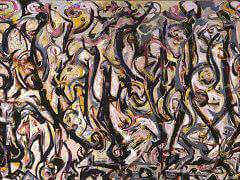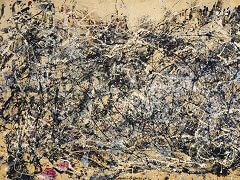Galaxy, 1947 by Jackson Pollock

Galaxy was created by Jackson Pollock 1947, and was exhibited on 1947 annual exhibition of the American Abstract Artists group. When art critics Clement Greenberg reviewed the 1947 exhibition, he complained that
"not one is bold, extravagant, pertinacious or obsessed"; obviously, he was measuring the participants against the new standard set by Jackson Pollock, for all of these adjectives perfectly describe the latter's new approach.
Hanging on the walls of the Parsons Gallery at 15 West Fifty-seventh Street were thirteen new canvases the likes of which New York had never seen. Pollock's freely admitted total retrenchment from traditional methods of oil
painting was patently obvious in Galaxy,
From the looks of its imagery, Galaxy - had begun in a similar vein to works of the previous year such as Eyes in the Heat. However, at some point in the process of painting,
Pollock laid down his brush and began instead to drip and spatter his pigment, not quite completely covering the underlayer, into which he also embedded small pieces of gravel to increase the texture.
At exactly what point and why Jackson Pollock decided to focus his efforts on a deliberate and sustained exploration of the possibilities of creating an entire composition by dripping or pouring paint is another "fact" of art
history that will never be definitively established. A full four years after his first experimentation with this technique Pollock returned to it with a vengeance, but also now with a logic and control that signaled his
maturity and independence of all of the well-known precedents for it. No longer content with the interruption to free movement caused each time he had to reload his brush, Pollock devised a handy way to create a more
continuous line by tilting a commercial can of thinner, more liquid paint, and allowing it to run down a stick placed in the can at an angle. In this way he believed that the energy behind his imagery could literally "flow"
straight from his unconscious.












